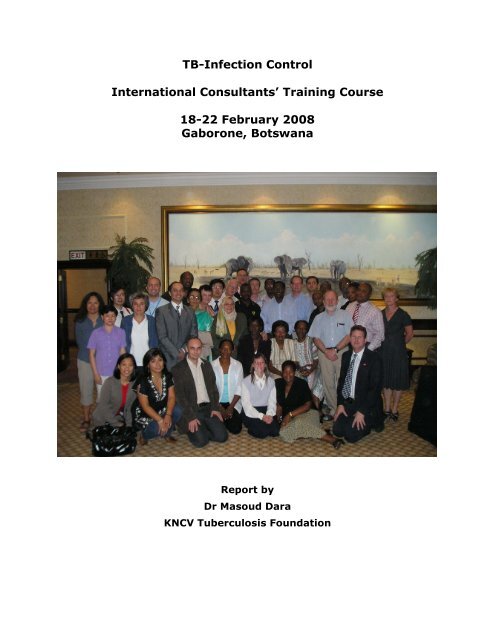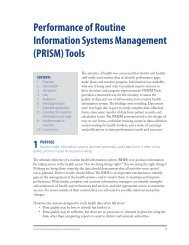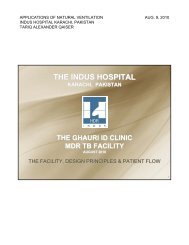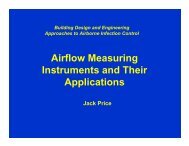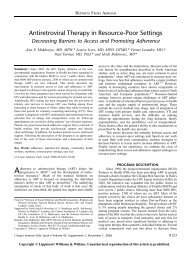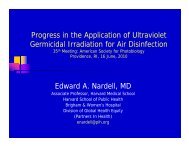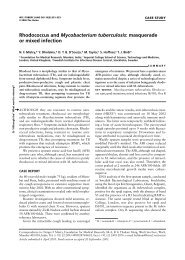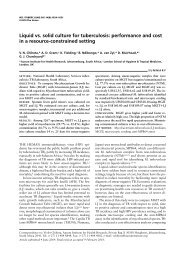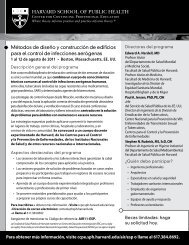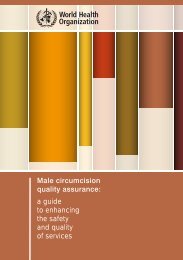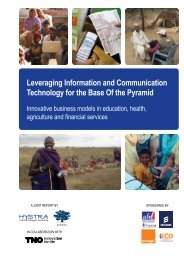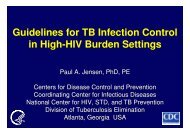International Consultants' Training Course - GHDonline
International Consultants' Training Course - GHDonline
International Consultants' Training Course - GHDonline
Create successful ePaper yourself
Turn your PDF publications into a flip-book with our unique Google optimized e-Paper software.
TB-Infection Control<br />
<strong>International</strong> Consultants’ <strong>Training</strong> <strong>Course</strong><br />
18-22 February 2008<br />
Gaborone, Botswana<br />
Report by<br />
Dr Masoud Dara<br />
KNCV Tuberculosis Foundation
TABLE OF CONTENTS<br />
ACKNOWLEDGEMENTS.............................................................................................2<br />
OUTLINE OF THE TRAINING COURSE.......................................................................3<br />
METHODOLOGY........................................................................................................4<br />
PROCESS .................................................................................................................4<br />
NEXT STEPS.............................................................................................................4<br />
COURSE AGENDA .....................................................................................................5<br />
SUMMARY OF END-COURSE EVALUATION BY PARTICIPANTS ..................................6<br />
ANNEX I: LIST OF PARTICIPANTS, FACILITATORS AND SECRETARIES.......................................................................... 9<br />
ANNEX II: INFECTION CONTROL ASSESSMENT EXERCISES ...................................................................................... 10<br />
GOAL ....................................................................................................................................................................... 10<br />
ANNEX III: APPLICATION FORM TO PARTICIPATE IN THE COURSE............................................................................. 25<br />
ANNEX IV: TABLE FOR FIELD VISIT.......................................................................................................................... 27<br />
1
Acknowledgements<br />
KNCV Tuberculosis Foundation would like to thank the Ministry of Health of Botswana,<br />
USAID, Centers for Disease Control and Prevention Botswana, TBCAP partners and<br />
participants who contributed to this training course.<br />
2
Outline of the <strong>Training</strong> course<br />
Introduction: Transmission of tuberculosis (TB) in health care and congregate<br />
settings is a major challenge to TB control and public health. However, many<br />
countries lack the institutional capacity to adequately address TB infection control.<br />
Recently, the importance of appropriate TB infection control has become<br />
increasingly acknowledged due to reports of an extensively drug resistant TB (XDR-<br />
TB) outbreak in South Africa which predominantly affected people living with<br />
HIV/AIDS. This outbreak had a very high case-fatality rate, included both patients<br />
and health care workers and was likely preventable had there been appropriate<br />
infection control measures in place. Nonetheless, at present, only a handful of<br />
qualified international and national experts are available to provide technical<br />
assistance in TB infection control training, planning, implementation and monitoring.<br />
Multiple international TB control partners in a coalition with TBCAP— including the<br />
US Centers for Disease Control and Prevention/American Thoracic Society, the<br />
KNCV Tuberculosis Foundation, the World Health Organization, the <strong>International</strong><br />
Union against TB and Lung Disease, Management Sciences for Health, Family Health<br />
<strong>International</strong>, Japan Anti-TB Association (JATA) among others— have acknowledged<br />
the importance of capacity development in TB infection control in developing<br />
countries.<br />
To this end, KNCV Tuberculosis Foundation, of behalf of TBCAP organized a training<br />
course in Gaborone, Botswana, 18-22 February 2008 to increase the number of<br />
qualified consultants available to conduct TB infection control assessments and to<br />
develop infection control plans, particularly for countries with a high burden of TB,<br />
high rates of HIV or high rates of MDR-TB.<br />
Criteria for selection and enrollment into this course:<br />
• Working experience as a consultant or willingness to work as a consultant in<br />
health related issues with particular emphasis on TB, HIV and/or airborne<br />
infections<br />
• Availability to participate in a one-week mission as an on-thejob/complementary<br />
training with an international TB infection control<br />
consultant (within one year after the training course)<br />
• Be available to conduct two field missions per year and provide requisite offsite<br />
follow-up<br />
The course focused on teaching following skills:<br />
o How to conduct a health facility TB infection control risk assessment<br />
o How to develop an infection control plan<br />
o How to implement the hierarchy of infection control measures<br />
o How to conduct missions as an international consultant (preparation,<br />
cultural aspects and safety issues)<br />
<strong>Course</strong> Coordinator: Dr Masoud Dara (KNCV Tuberculosis Foundation)<br />
Facilitators: Paul Jensen (CDC/USA), Masoud Dara (KNCV), Rose Pray (WHO-HQ),<br />
Nancy Jensen (CDC/USA on leave), Cristi Popa (Institute Pneumolog Romania/Free<br />
Lancer), Scano Fabio (WHO-HQ)<br />
Secretaries/logistics: Orlanda Graca (KNCV), Susan Makani (Free lancer)<br />
3
o<br />
o<br />
o<br />
o<br />
o<br />
Methodology<br />
Presentations by facilitators in the plenary<br />
Introductory presentation of each level of Infection control hierarchy<br />
Questions and Answers during and after each presentations, sharing country<br />
experiences on TB Infection control<br />
Field visit to Inpatients and outpatients and facility risk assessment in small<br />
groups<br />
Reporting observations and recommendation back in the plenary<br />
Process<br />
The organizing committee (facilitators) prepared an application form and first<br />
announcement in December 2007 and sent it around through their network of national<br />
and international partners. In total 37 applications were received, based on selection<br />
criteria, 33 participants were selected of whom three were self funded and the rest were<br />
funded through TBCAP mechanism and its partners. Two participants could not attend<br />
due to administrative problems (loss of passport, lack of available paper ticket). 31<br />
participants attended the course.<br />
Anonymous pre-test and post-test examinations were carried out so that each<br />
participant may assess himself/herself individually.<br />
An end-course evaluation by participants was conducted, summary of which you may<br />
find in this report.<br />
After the course, a rooster Excel sheet was prepared and sent to participants. Most<br />
participants indicated their availabilities for mentorship process in order to gain more<br />
experience on TB-IC.<br />
Next Steps<br />
The faculty met after the training course and agreed to do their best to make sure there<br />
is a follow-up for the training course. Most participants do not feel competent to conduct<br />
TB-IC missions on their own. There will be different types of TB-IC linked missions which<br />
vary from technical assessment on programmatic aspects of TB-IC, MDR-TB missions<br />
with link to TB-IC and full TB-IC assessment missions with detailed<br />
environmental/engineering aspects. The follow-up will be done by different TBCAP<br />
partners. The follow-up mechanism will be linked to other TBCAP initiatives, including<br />
developing the overall HRD strategy of TB-IC and coordination of mentorship process.<br />
4
<strong>Course</strong> Agenda<br />
Time Day 1<br />
18 Feb 08<br />
8.00 - 10.00 Unit 1: Welcome<br />
by authorities and<br />
course organizers<br />
/Opening Session<br />
(and pre-test)<br />
Unit 2:<br />
Introduction to TB<br />
Day 2<br />
19 Feb 08<br />
Unit 9:<br />
Environmental<br />
(engineering)<br />
controls<br />
Day 3<br />
20 Feb 08<br />
Day 4<br />
21 Feb 08<br />
Day 5<br />
22 Feb 08<br />
Unit 12: Field visit 1 Unit 15: Field visit 2 Unit 18: Development<br />
and review of TB<br />
Infection Control plans<br />
10.00– 10.30 Coffee/Tea Coffee/Tea Coffee/Tea Coffee/Tea Coffee/Tea<br />
10.30– 12.30 Unit 3: Infection<br />
control for TB<br />
control<br />
Unit 9: continue Unit 12: continue Unit 15: continue Unit 19: Conducting TB<br />
Infection Control<br />
assessments<br />
Unit 4:<br />
Administrative<br />
controls<br />
12.30– 13.30 Lunch Lunch Lunch Lunch Lunch<br />
13.30– 15.30 Unit 4:<br />
Administrative<br />
controls<br />
(continued)<br />
Unit 9: continue Unit 12: continue Unit 16: Field visit 3 Unit 20: Critical<br />
elements to ensure<br />
optimal impact as a<br />
consultant<br />
Unit 5: Infection<br />
control plan<br />
Unit 6:<br />
Introduction to<br />
bloodborne<br />
pathogens<br />
15.30 - 16.00 Coffee/Tea Coffee/Tea Coffee/Tea Coffee/Tea Coffee/Tea<br />
16.00 - 18.00 Unit 7: Respiratory<br />
Unit 21: Post-test<br />
protection<br />
Unit 8: Respirator<br />
Fit Testing<br />
Unit 10: Virtual tour<br />
of selected<br />
healthcare settings<br />
Unit 11: Logistics<br />
and objectives for<br />
Field Visit 1<br />
Unit 13: Debrief of Field<br />
Visit 1<br />
`<br />
Unit 14: Logistics and<br />
objectives for Field Visits 2<br />
& 3<br />
Unit 17: Debrief of Field<br />
Visits 2 & 3<br />
`<br />
Unit 22: <strong>Course</strong><br />
Evaluation and<br />
certificates<br />
Unit 23: Charge to<br />
participants and closure<br />
5
Summary of end-course evaluation by participants<br />
We received course evaluations from the vast majority of participants (29/31).<br />
Twenty-seven participants (93%) indicated that the course met their expectations.<br />
However, some feedback for improvement was included (selected two or more<br />
participants mentioned this) as follows:<br />
• The course evaluation must be anonymous as names were asked and this<br />
potentially biases the candidness of participants<br />
• The course should be better guided by evidence and references to such<br />
evidence, such as in a course reader for each section. More on what is not<br />
know would also be useful. Pre-distribution of the literature CD-rom would<br />
be preferable than handing it out at the end of the course.<br />
• The costing and budgeting for TB-IC to support funding efforts, such as via<br />
the Global Fund, should be explicitly instructed<br />
• The course should have smaller group break out sessions and the first two<br />
days did not allow enough interaction.<br />
• The course, per many participants, should be more focused.<br />
• The environmental control lectures were not focused enough and more time<br />
could be dedicated to this subject area.<br />
• The clinic visits could have been shortened<br />
• Provide more details of the writing of an infection control plan and perhaps<br />
have a mock infection control plan writing with budgeting<br />
• The blood-borne pathogens should be shortened or completely deleted from<br />
the course.<br />
• The course days were too long and this was not conducive for learning. The<br />
lunch hour could be extended to 2 hours instead of one, for instance. Or the<br />
course could end on Friday after lunch. Friday was very packed. Could<br />
consider ending the course at 4:30PM per day and possibly extended by<br />
another day if the content needs to be made up. Could consider having the<br />
field visits for only ½ day. Consider having additional 5 minute breaks.<br />
Generally, sessions should not last longer than 1 hour.<br />
• On overall outline of the course should be given on the 1st day.<br />
• Overall take home messages:<br />
o Could engage the trained consultant so that they do not forget via<br />
international missions. Did not focus enough on these possibilities on<br />
the last day.<br />
o Special website for the TB IC consultant would be beneficial<br />
o Need to have objectives for each session and not stray off course from<br />
the stated objectives<br />
o<br />
o<br />
Make more use of expertise in the room e.g., with small group sessions<br />
Change order of lectures to start more with the big picture, assessment<br />
then technical details<br />
• Other: name tags might be useful, folders for materials, toolkit to take<br />
home, evaluations could be done per day instead of at the end, coffee and<br />
tea should be provided all day long and perhaps u-shaped seating<br />
arrangements are better.<br />
6
Participant survey at the End of <strong>Training</strong> <strong>Course</strong><br />
TB-IC training course for <strong>International</strong> consultants<br />
Gaborone 18-22 February 2008<br />
Name: _______________________________<br />
Country: ____________________<br />
Organization/Institution (if applicable): __________________<br />
Now that you have finished the training course, please answer the following questions.<br />
1. Did the training course fulfill your expectations? yes / no (please explain briefly your answer)<br />
_____________27/29 (yes)<br />
______________________________________________________________________________<br />
______________________________________________________________________________<br />
_________________________________<br />
2. Was the training course interactive enough? Yes/no. Was enough time given for each session?<br />
yes / no (please explain briefly your answers)<br />
28/29 Yes Interactive enough<br />
______________________________________________________________________________<br />
________________________8/29 said that the sessions were given enough time whereas<br />
11/29 said that there was not enough time given to sessions<br />
______________________________________________________________________________<br />
____________________________________________________________<br />
3. How do you evaluate the role of facilitators? Please explain<br />
Please see summary in the previous page<br />
______________________________________________________________________________<br />
______________________________________________________________________________<br />
__________________________________________<br />
4. Would you modify the structure/modules of the training course? Yes/no if yes: 18/29 said yes<br />
they would modify something, please see the summary in the previous page<br />
4a) What would you<br />
add?__________________________________________________________________<br />
______________________________________________________________________________<br />
___________________________________________________________________________<br />
4b)What would you<br />
delete?________________________________________________________________<br />
______________________________________________________________________________<br />
___________________________________________________________________________<br />
4c) How about the order of the sessions? ______________14/29 said the order was<br />
alright________________________________________________________________________<br />
______________________________________________________________________________<br />
____________________________________________________________________________<br />
7
5. How did you find the field visits? (In terms of relevancy, usefulness and time-management<br />
etc.)<br />
5a) Hospital:<br />
______________________________________________________________________________<br />
_______<br />
__________________________ please see the summary in the previous page<br />
______________________________________________________________________________<br />
___________________________________________________<br />
5b)<br />
Clinics:________________________________________________________________________<br />
_____<br />
_________________ please see the summary in the previous page<br />
______________________________________________________________________________<br />
______________________________________________________________________________<br />
____________________________________________<br />
6. Would you recommend this sort of international TB-IC training course to other coworkers/colleagues<br />
(TB consultants, national partners, engineers/architects/infection control<br />
specialists etc.) yes / no,<br />
If yes, to whom would you recommend it? If you have name and contacts, please add them<br />
below.<br />
______________________________________________________________________________<br />
_______________________________________27/29 said that they would recommend the<br />
course to others and many left recommended names of<br />
contacts._________________________________________________________<br />
______________________________________________________________________________<br />
______________________________________________________________________________<br />
Few provided names which will be used to contact<br />
______________________________________________________________________________<br />
____________________________________<br />
7. Did you have the opportunity to do the fit testing? Yes/no, if no, why?<br />
_______20/29 had fit testing __________________other mentioned they did not have enough<br />
time<br />
8. What else would you need in order to develop further your knowledge and/or<br />
skills/competencies in TB infection control assessment/consultancy?<br />
______________________________________________________________________________<br />
________Most mentioned they need to be involved in the mentorship process to develop<br />
further their skills<br />
______________________________________________________________________________<br />
9. Please add further comments/take-home message or suggestions you may have.<br />
______________________________________________________________________________<br />
please see the summary in the previous pages ____<br />
8
Annex I: List of participants, facilitators and secretaries<br />
Participants<br />
FIRST NAME FAMILY NAME COUNTRY EMAIL<br />
Marième Ba Sourang Italy mbasourang@yahoo.fr<br />
Marijke Bleumink Belgium marijke.becx@gmail.com<br />
Mayindo Kagubare USA jkagubare@msh.org<br />
Grace Egos Philippines grace_egos@tdf.org.ph<br />
Judith Glynn UK judith.glynn@lshtm.ac.uk<br />
Guangxue He China heguangxue@chinatb.org<br />
Luc Janssens Belgium luc@msci.ge<br />
Kitty Lambregts-van Weezenbeek The Netherlands lambregtsk@kncvtbc.nl<br />
Rajeswari Ramachandran India rajerama@yahoo.com<br />
Maria Angélica Salomão Zimbabwe salomaoa@zw.afro.who.int<br />
Jerod Scholten The Netherlands scholtenj@kncvtbc.nl<br />
Takashi Yoshiyama Japan yoshiyama@jata.or.jp<br />
Seraphine Kabanje Zambia skabanje@fhizambia.org<br />
Mustapha Gidado Nigeria gidadomansu@yahoo.com.au<br />
Samar Abdel Sattar Egypt hass_361112@yahoo.com<br />
Isabel Ochoa Peru isa_ochoad@yahoo.es<br />
Margarita Villafañe Britos Paraguay daisyvbr@yahoo.com<br />
Nguyet Thu Huyen Mai Vietnam maihuyen1967@yahoo.com<br />
Robin Vincent-Smith South Africa robin.smith@msf.org.za<br />
Nii Nortey Hanson-Nortey Ghana nii.nortey@ghsmail.org<br />
Tore Steen Botswana tsteen@gov.bw<br />
Jeffrey Hafkin Botswana hafkin@gmail.com<br />
Ezra Tessera Ethiopia ezraashi@yahoo.com<br />
Norbert Ndjeka South Africa norbertn@tasc-tb.co.za<br />
Godwin Munuo Tanzania gmunuo@path.org<br />
Charles Daley USA daleyc@njc.org<br />
Samson Haumba Swaziland samsonh@qap.co.za<br />
Oaitse Ipeleng Motsamai Botswana oimotsamai@gov.bw<br />
Koobiditse Radisowa Botswana radisowak@bw.cdc.gov<br />
Boingotlo M. Gasennelwe Botswana gasennelweb@bw.afro.who.int<br />
Robert Makombe Botswana MakombeR@bw.cdc.gov<br />
Facilitators<br />
First name Last name Institute-Location Email<br />
Paul Jensen CDC/USA pej4@cdc.gov<br />
Masoud Dara KNCV/Netherlands daram@kncvtbc.nl<br />
Rose Pray WHO/Geneva prayr@who.int<br />
Nancy Jensen CDC/USA nbj9@cdc.gov<br />
Cristi<br />
Popa<br />
Institute<br />
Pneumolog/Romania<br />
cripooh@yahoo.com<br />
Fabio Scano WHO/Geneva scanof@who.int<br />
Secretaries/Logistics<br />
First name Last name Institute/Location Email<br />
Orlanda Graca KNCV/Netherlands gracao@kncvtbc.nl<br />
Susan Makani Botswana suemak4@gmail.com<br />
9
Annex II: Infection Control Assessment Exercises<br />
Infection Control Assessment Exercises<br />
21 February 2008<br />
Goal<br />
To conduct snippets of a TB IC assessment of selected settings at Julia Molefhe and Old Naledi<br />
Clinics.<br />
Procedure<br />
All groups will cycle through all four exercise locations. Not all the exercises below will be<br />
completed by every group; however, the exercises listed below will be used by you and your<br />
facilitators as a general guide.<br />
Schedule<br />
Please strictly adhere to the time schedule below:<br />
Time<br />
Background<br />
and Patient<br />
Flow<br />
08:00-08:30 Group #1&2<br />
DOT Room<br />
(Admin &<br />
Environ<br />
Controls)<br />
Julia Molefhe Clinic<br />
Future ARV Site<br />
(Admin Controls)<br />
Peds and Waiting<br />
Room<br />
(Admin and<br />
Environ Controls)<br />
Nancy & Cristi Cristi Nancy Nancy/Cristi<br />
08:30-09:30 Group #1 Group #2<br />
09:30-10:30 Group #2 Group #1<br />
10:30-11:30 Group #2 Group #1<br />
11:30-12:30 Transfer to Old Naledi Clinic and Lunch<br />
12:30- 13:00 Group #3&4<br />
13:00 -14:00 Group #3 Group #4<br />
14:00 - 15:00 Group #4 Group #3<br />
15:00-16:00 Group #4 Group #3<br />
16:00 Transfer to Gaborone Sun Hotel<br />
10
Time<br />
Background<br />
and Patient<br />
Flow<br />
Masoud &<br />
Isabel<br />
08:00 -08:30 Group #3&4<br />
DOT Room<br />
(Admin &<br />
Environ<br />
Controls)<br />
Old Naledi Clinic<br />
Exam Rooms w/<br />
Small Waiting<br />
Area (center)<br />
(Admin Controls)<br />
Larger Waiting<br />
Area<br />
(Admin and<br />
Environ Controls)<br />
Isabel Masoud Masoud/Isabel<br />
08:30 -09:30 Group #3 Group #4<br />
09:30 -10:30 Group #4 Group #3<br />
10:30 -11:30 Group #4 Group #3<br />
11:30 -12:30 Transfer to Julia Molefhe Clinic and Lunch<br />
12:30 -13:00 Group #1&2<br />
13:00 - 14:00 Group #1 Group #2<br />
14:00 - 15:00 Group #2 Group #1<br />
15:00 -16:00 Group #2 Group #1<br />
16:00 Transfer to Gaborone Sun Hotel<br />
11
Infection Control Assessment Exercises<br />
21 February 2008<br />
Background and Patient Flow<br />
Date: 21 February 2008_____________________ Time: __________________<br />
Location: Julia Molefhe Clinic ____________<br />
Room number: ___________<br />
Purpose of room: ________________________________________________________<br />
General background information:<br />
Number of patients<br />
Number of suspect TB patients<br />
Number of known TB patients<br />
Number increasing, steady, decreasing?<br />
Time from registration to:<br />
Seeing Nurse<br />
Seeing Doctor<br />
Sputum collection<br />
Sputum results<br />
Preliminary diagnosis<br />
Admission to TB ward or referral<br />
Where do they wait?<br />
Perceived risk<br />
TB incidence among staff<br />
Contact with patients<br />
IC procedures and policies in place<br />
Other . . . __________________________________________________<br />
__________________________________________________________<br />
__________________________________________________________<br />
__________________________________________________________<br />
Observe path of patient:<br />
Create flowchart of the path of patients in the admission ward (registration, vital signs,<br />
waiting, exam, procedures, radiology, sputum collection, other procedures, etc.)<br />
Flowchart path of patient:<br />
12
Infection Control Assessment Exercises<br />
21 February 2008<br />
Assessment of the DOT Area<br />
Date: 21 February 2008_____________________ Time: __________________<br />
Location: Julia Molefhe Clinic____________<br />
Room number: ___________<br />
Purpose of room: ________________________________________________________<br />
General background information:<br />
Number of patients<br />
Number of suspect TB patients<br />
Number of known TB patients<br />
Number increasing, steady, decreasing?<br />
Time from registration to:<br />
Seeing Nurse<br />
Seeing Doctor<br />
Sputum collection<br />
Sputum results<br />
Preliminary diagnosis<br />
Admission to TB ward or referral<br />
Where do they wait?<br />
Perceived risk<br />
TB incidence among staff<br />
Contact with patients<br />
IC procedures and policies in place<br />
Other . . . __________________________________________________<br />
__________________________________________________________<br />
__________________________________________________________<br />
__________________________________________________________<br />
Draw the room:<br />
13
Room dimensions: Width ____________ Depth ____________ Ceiling _________<br />
(List all dimensions on drawing)<br />
Mark ventilation pipes/grilles on drawing. Label as supply air or exhaust air.<br />
Air Exchange Rate Calculations:<br />
Dimensions of Window openings: Width (W) ____m<br />
Width (W) ____m<br />
Width (W) ____m<br />
Height (H) ____m<br />
Height (H) ____m<br />
Height (H) ____m<br />
Area (W • H): ________ m 2<br />
Area (W • H): ________ m 2<br />
Area (W • H): ________ m 2<br />
Velocity measurements: Window 1<br />
Velocity #1 ________ m/s Velocity #2 ________ m/s<br />
Velocity #3 ________ m/s Velocity #4 ________ m/s<br />
Velocity #5 ________ m/s Velocity #6 ________ m/s<br />
Velocity #7 ________ m/s Velocity #8 ________ m/s<br />
Velocity #9 ________ m/s Velocity #10 ________ m/s<br />
Average Velocity: ________ m/s<br />
Average Airflow Rate:<br />
Airflow Rate = Area • Average Velocity<br />
________ m 2 • ________ m/s • 3 600 s/h<br />
________ m 3 /h<br />
Velocity measurements: Window 2<br />
Velocity #1 ________ m/s Velocity #2 ________ m/s<br />
Velocity #3 ________ m/s Velocity #4 ________ m/s<br />
Velocity #5 ________ m/s Velocity #6 ________ m/s<br />
Velocity #7 ________ m/s Velocity #8 ________ m/s<br />
Velocity #9 ________ m/s Velocity #10 ________ m/s<br />
Average Velocity: ________ m/s<br />
Average Airflow Rate:<br />
Airflow Rate = Area • Average Velocity<br />
________ m 2 • ________ m/s • 3 600 s/h<br />
________ m 3 /h<br />
Pressure differential (smoke test):<br />
Room to hallway: ____ Positive ____ Negative<br />
Airflow patterns (smoke test):<br />
Sketch on the plan<br />
14
Infection Control Assessment Exercises<br />
21 February 2008<br />
Design of Proposed ARV Site<br />
Date: 21 February 2008_____________________ Time: __________________<br />
Location: Julia Molefhe Clinic ____________<br />
Room number: ___________<br />
Purpose of room: ________________________________________________________<br />
General background information (we will make some assumptions):<br />
Number of patients<br />
Number increasing<br />
Perceived risk<br />
TB incidence among staff<br />
Contact with patients<br />
IC policies and procedures in place<br />
Other . . .<br />
List functional procedures and space requirements for the potential ARV site<br />
Sketch the available rooms<br />
Sketch proposed flow of patients and staff<br />
Include proposed UV lights, ventilation grilles, air cleaners, beds, doors,<br />
elevators, misc rooms, waiting rooms . . .<br />
Estimate room dimensions<br />
Draw proposal of new ARV site<br />
15
Infection Control Assessment Exercises<br />
21 February 2008<br />
Pediatrics and Waiting Areas<br />
Date: 21 February 2008_____________________ Time: __________________<br />
Location: Julia Molefhe Clinic ____________<br />
Room number: ___________<br />
Purpose of room: ________________________________________________________<br />
General background information:<br />
Number of patients (planned)<br />
Composition of patients<br />
Number increasing, steady, decreasing<br />
Perceived risk<br />
TB incidence among staff<br />
Contact with patients<br />
IC procedures and policies in place<br />
Other . . . __________________________________________________<br />
__________________________________________________________<br />
__________________________________________________________<br />
__________________________________________________________<br />
Observe path of patient through area:<br />
Create flowchart of the path of patients in the ward (procedures, medications, radiology,<br />
sputum collection, other procedures, etc.)<br />
Room dimensions: Width ____________ Depth ____________ Ceiling _________<br />
(List all dimensions on drawing)<br />
Mark ventilation pipes/grilles on drawing. Label as supply air or exhaust air.<br />
Air Exchange Rate Calculations:<br />
Dimensions of Window openings: Width (W) ____m<br />
Width (W) ____m<br />
Width (W) ____m<br />
Height (H) ____m<br />
Height (H) ____m<br />
Height (H) ____m<br />
Area (W • H): ________ m 2<br />
Area (W • H): ________ m 2<br />
Area (W • H): ________ m 2<br />
Velocity measurements: Window 1<br />
Velocity #1 ________ m/s Velocity #2 ________ m/s<br />
Velocity #3 ________ m/s Velocity #4 ________ m/s<br />
Velocity #5 ________ m/s Velocity #6 ________ m/s<br />
Velocity #7 ________ m/s Velocity #8 ________ m/s<br />
Velocity #9 ________ m/s Velocity #10 ________ m/s<br />
Average Velocity: ________ m/s<br />
Average Airflow Rate:<br />
Airflow Rate = Area • Average Velocity<br />
16
________ m 2 • ________ m/s • 3 600 s/h<br />
________ m 3 /h<br />
Velocity measurements: Window 2<br />
Velocity #1 ________ m/s Velocity #2 ________ m/s<br />
Velocity #3 ________ m/s Velocity #4 ________ m/s<br />
Velocity #5 ________ m/s Velocity #6 ________ m/s<br />
Velocity #7 ________ m/s Velocity #8 ________ m/s<br />
Velocity #9 ________ m/s Velocity #10 ________ m/s<br />
Average Velocity: ________ m/s<br />
Average Airflow Rate:<br />
Airflow Rate = Area • Average Velocity<br />
________ m 2 • ________ m/s • 3 600 s/h<br />
________ m 3 /h<br />
Pressure differential (smoke test):<br />
Room to hallway: ____ Positive ____ Negative<br />
Airflow patterns (smoke test):<br />
Sketch on plan<br />
Alternative procedures and location for waiting area?<br />
17
Infection Control Assessment Exercises<br />
21 February 2008<br />
Background and Patient Flow<br />
Date: 21 February 2008_____________________ Time: __________________<br />
Location: Julia Molefhe Clinic ____________<br />
Room number: ___________<br />
Purpose of room: ________________________________________________________<br />
General background information:<br />
Number of patients<br />
Number of suspect TB patients<br />
Number of known TB patients<br />
Number increasing, steady, decreasing?<br />
Time from registration to:<br />
Seeing Nurse<br />
Seeing Doctor<br />
Sputum collection<br />
Sputum results<br />
Preliminary diagnosis<br />
Admission to TB ward or referral<br />
Where do they wait?<br />
Perceived risk<br />
TB incidence among staff<br />
Contact with patients<br />
IC procedures and policies in place<br />
Other . . . __________________________________________________<br />
__________________________________________________________<br />
__________________________________________________________<br />
__________________________________________________________<br />
Observe path of patient:<br />
Create flowchart of the path of patients in the admission ward (registration, vital signs,<br />
waiting, exam, procedures, radiology, sputum collection, other procedures, etc.)<br />
Flowchart path of patient:<br />
18
21 February 2008<br />
Assessment of the DOT Area<br />
Date: 21 February 2008_____________________ Time: __________________<br />
Location: Old Naledi Clinic___________________ Room number: ___________<br />
Purpose of room: ________________________________________________________<br />
General background information:<br />
Number of patients (planned)<br />
Composition of patients (drug susceptible or drug resistant)<br />
Number increasing, steady, decreasing<br />
Perceived risk<br />
TB incidence among staff<br />
Contact with patients<br />
IC procedures and policies in place<br />
Other . . . __________________________________________________<br />
__________________________________________________________<br />
__________________________________________________________<br />
__________________________________________________________<br />
Draw the room:<br />
Room dimensions: Width ____________ Depth ____________ Ceiling _________<br />
(List all dimensions on drawing)<br />
Mark ventilation pipes/grilles on drawing. Label as supply air or exhaust air.<br />
Air Exchange Rate Calculations:<br />
Dimensions of Window openings: Width (W) ____m<br />
Width (W) ____m<br />
Width (W) ____m<br />
Height (H) ____m<br />
Height (H) ____m<br />
Height (H) ____m<br />
Area (W • H): ________ m 2<br />
Area (W • H): ________ m 2<br />
Area (W • H): ________ m 2<br />
Velocity measurements: Window 1<br />
Velocity #1 ________ m/s Velocity #2 ________ m/s<br />
Velocity #3 ________ m/s Velocity #4 ________ m/s<br />
Velocity #5 ________ m/s Velocity #6 ________ m/s<br />
Velocity #7 ________ m/s Velocity #8 ________ m/s<br />
Velocity #9 ________ m/s Velocity #10 ________ m/s<br />
Average Velocity: ________ m/s<br />
Average Airflow Rate:<br />
19
Airflow Rate = Area • Average Velocity<br />
________ m 2 • ________ m/s • 3 600 s/h<br />
________ m 3 /h<br />
Velocity measurements: Window 2<br />
Velocity #1 ________ m/s Velocity #2 ________ m/s<br />
Velocity #3 ________ m/s Velocity #4 ________ m/s<br />
Velocity #5 ________ m/s Velocity #6 ________ m/s<br />
Velocity #7 ________ m/s Velocity #8 ________ m/s<br />
Velocity #9 ________ m/s Velocity #10 ________ m/s<br />
Average Velocity: ________ m/s<br />
Average Airflow Rate:<br />
Airflow Rate = Area • Average Velocity<br />
________ m 2 • ________ m/s • 3 600 s/h<br />
________ m 3 /h<br />
Pressure differential (smoke test):<br />
Room to hallway: ____ Positive ____ Negative<br />
Airflow patterns (smoke test):<br />
Sketch on the plan<br />
20
Infection Control Assessment Exercises<br />
21 February 2008<br />
Assessment of the Exam Rooms in small waiting area<br />
Date: 21 February 2008_____________________ Time: __________________<br />
Location: Old Naledi Clinic___________________ Room number: ___________<br />
Purpose of room: ________________________________________________________<br />
General background information:<br />
Number of patients (planned)<br />
Composition of patients (drug susceptible or drug resistant)<br />
Number increasing, steady, decreasing<br />
Perceived risk<br />
TB incidence among staff<br />
Contact with patients<br />
IC procedures and policies in place<br />
Other . . . __________________________________________________<br />
__________________________________________________________<br />
__________________________________________________________<br />
__________________________________________________________<br />
Draw the room:<br />
21
Room dimensions: Width ____________ Depth ____________ Ceiling _________<br />
(List all dimensions on drawing)<br />
Mark ventilation pipes/grilles on drawing. Label as supply air or exhaust air.<br />
Air Exchange Rate Calculations:<br />
Dimensions of Window openings: Width (W) ____m<br />
Width (W) ____m<br />
Width (W) ____m<br />
Height (H) ____m<br />
Height (H) ____m<br />
Height (H) ____m<br />
Area (W • H): ________ m 2<br />
Area (W • H): ________ m 2<br />
Area (W • H): ________ m 2<br />
Velocity measurements: Window 1<br />
Velocity #1 ________ m/s Velocity #2 ________ m/s<br />
Velocity #3 ________ m/s Velocity #4 ________ m/s<br />
Velocity #5 ________ m/s Velocity #6 ________ m/s<br />
Velocity #7 ________ m/s Velocity #8 ________ m/s<br />
Velocity #9 ________ m/s Velocity #10 ________ m/s<br />
Average Velocity: ________ m/s<br />
Average Airflow Rate:<br />
Airflow Rate = Area • Average Velocity<br />
________ m 2 • ________ m/s • 3 600 s/h<br />
________ m 3 /h<br />
Velocity measurements: Window 2<br />
Velocity #1 ________ m/s Velocity #2 ________ m/s<br />
Velocity #3 ________ m/s Velocity #4 ________ m/s<br />
Velocity #5 ________ m/s Velocity #6 ________ m/s<br />
Velocity #7 ________ m/s Velocity #8 ________ m/s<br />
Velocity #9 ________ m/s Velocity #10 ________ m/s<br />
Average Velocity: ________ m/s<br />
Average Airflow Rate:<br />
Airflow Rate = Area • Average Velocity<br />
________ m 2 • ________ m/s • 3 600 s/h<br />
________ m 3 /h<br />
Pressure differential (smoke test):<br />
Room to hallway: ____ Positive ____ Negative<br />
Airflow patterns (smoke test):<br />
Sketch on the plan<br />
22
Infection Control Assessment Exercises<br />
21 February 2008<br />
Assessment of the Larger Waiting Area<br />
Date: 21 February 2008_____________________ Time: __________________<br />
Location: Old Naledi Clinic___________________ Room number: ___________<br />
Purpose of room: ________________________________________________________<br />
General background information:<br />
Number of patients (planned)<br />
Composition of patients (drug susceptible or drug resistant)<br />
Number increasing, steady, decreasing<br />
Perceived risk<br />
TB incidence among staff<br />
Contact with patients<br />
IC procedures and policies in place<br />
Other . . . __________________________________________________<br />
__________________________________________________________<br />
__________________________________________________________<br />
__________________________________________________________<br />
Sketch room. Include main room, anteroom, hallway, UV lights, room air cleaners, other<br />
controls windows, doors, bed, and major furniture.<br />
Room dimensions: Width ____________ Depth ____________ Ceiling _________<br />
(List all dimensions on drawing)<br />
Mark ventilation pipes/grilles on drawing. Label as supply air or exhaust air.<br />
Air Exchange Rate Calculations:<br />
Dimensions of Window openings: Width (W) ____m<br />
Width (W) ____m<br />
Width (W) ____m<br />
Height (H) ____m<br />
Height (H) ____m<br />
Height (H) ____m<br />
Area (W • H): ________ m 2<br />
Area (W • H): ________ m 2<br />
Area (W • H): ________ m 2<br />
Velocity measurements: Window 1<br />
Velocity #1 ________ m/s Velocity #2 ________ m/s<br />
Velocity #3 ________ m/s Velocity #4 ________ m/s<br />
Velocity #5 ________ m/s Velocity #6 ________ m/s<br />
Velocity #7 ________ m/s Velocity #8 ________ m/s<br />
Velocity #9 ________ m/s Velocity #10 ________ m/s<br />
Average Velocity: ________ m/s<br />
Average Airflow Rate:<br />
Airflow Rate = Area • Average Velocity<br />
23
________ m 2 • ________ m/s • 3 600 s/h<br />
________ m 3 /h<br />
Velocity measurements: Window 2<br />
Velocity #1 ________ m/s Velocity #2 ________ m/s<br />
Velocity #3 ________ m/s Velocity #4 ________ m/s<br />
Velocity #5 ________ m/s Velocity #6 ________ m/s<br />
Velocity #7 ________ m/s Velocity #8 ________ m/s<br />
Velocity #9 ________ m/s Velocity #10 ________ m/s<br />
Average Velocity: ________ m/s<br />
Average Airflow Rate:<br />
Airflow Rate = Area • Average Velocity<br />
________ m 2 • ________ m/s • 3 600 s/h<br />
________ m 3 /h<br />
Pressure differential (smoke test):<br />
Room to hallway: ____ Positive ____ Negative<br />
Airflow patterns (smoke test):<br />
Sketch on the plan<br />
Other administrative or environmental controls?<br />
24
Annex III: Application form to participate in the course<br />
Application Form<br />
Please fax or email this form along the professional profile form<br />
No later than 15 January 2007<br />
Our direct fax number: +31-70-358 4004 (attn. Ms Orlanda Graca, GracaO@kncvtbc.nl)<br />
Name Participant:<br />
Address:<br />
Tel.: _____<br />
Email:<br />
Fax:<br />
For visa purposes:<br />
Nationality: _______________<br />
Passport number:____________<br />
Date of birth: ________________<br />
The organizing committee will review the applications and select the most<br />
suitable candidates by 31 January 2008. Once participants are selected,<br />
KNCV Tuberculosis Foundation will send a confirmation note and assist<br />
with travel arrangements. Based on the flight schedule, room reservation<br />
will be confirmed.<br />
Please indicate the exact title and full name as you would like to appear on<br />
your certificate of attendance:<br />
____________________________________________<br />
Please indicate if you have any special diet: Yes/No<br />
If yes please define: _______________<br />
Signature<br />
Date:<br />
25
In order to select the most eligible candidates for this course, may we kindly ask you to fill<br />
in the below Short professional profile form:<br />
Name (First name and Family name)<br />
Sex<br />
Current position<br />
(indicate your affiliation and responsibility, e.g.<br />
NTP officer, HIV/AIDS program officer, Nursing<br />
section, occupational health, etc.)<br />
Professional background (Medical doctor, nurse,<br />
engineer, health officer, etc.…)<br />
What are your current tasks and<br />
responsibilities in the field of infection<br />
control?<br />
Have you ever before participated in training on<br />
non-TB related infection control?<br />
Have you ever received training on TB Infection<br />
Control? If so, when and by whom?<br />
Yes/No<br />
Yes/No, …<br />
Have you been conducting consultancy missions<br />
in the past, if yes since when, in which fields and<br />
to which countries/regions<br />
Name and contact details of your<br />
supervisor/coordinator<br />
What are your expectations of the course?<br />
Will you be able to commit to 2-4 TB-IC related<br />
missions per year? If so to which<br />
countries/region(s)<br />
26
Annex IV: Table for field visits<br />
Prioritization Table for TB IC Assessment & Intervention (1/2)<br />
IC Hierarchy Priority Description How to<br />
implement?<br />
Administrative<br />
Controls<br />
When to<br />
implement?<br />
Budget (shortand<br />
long-term)<br />
What obstacles might<br />
you face?<br />
27
Prioritization Table for TB IC Assessment & Intervention (2/2)<br />
IC Hierarchy Priority Description How to<br />
implement?<br />
Environmental<br />
Controls<br />
When to<br />
implement?<br />
Budget (shortand<br />
long-term)<br />
What obstacles<br />
might you face?<br />
Respiratory<br />
Protection<br />
28


